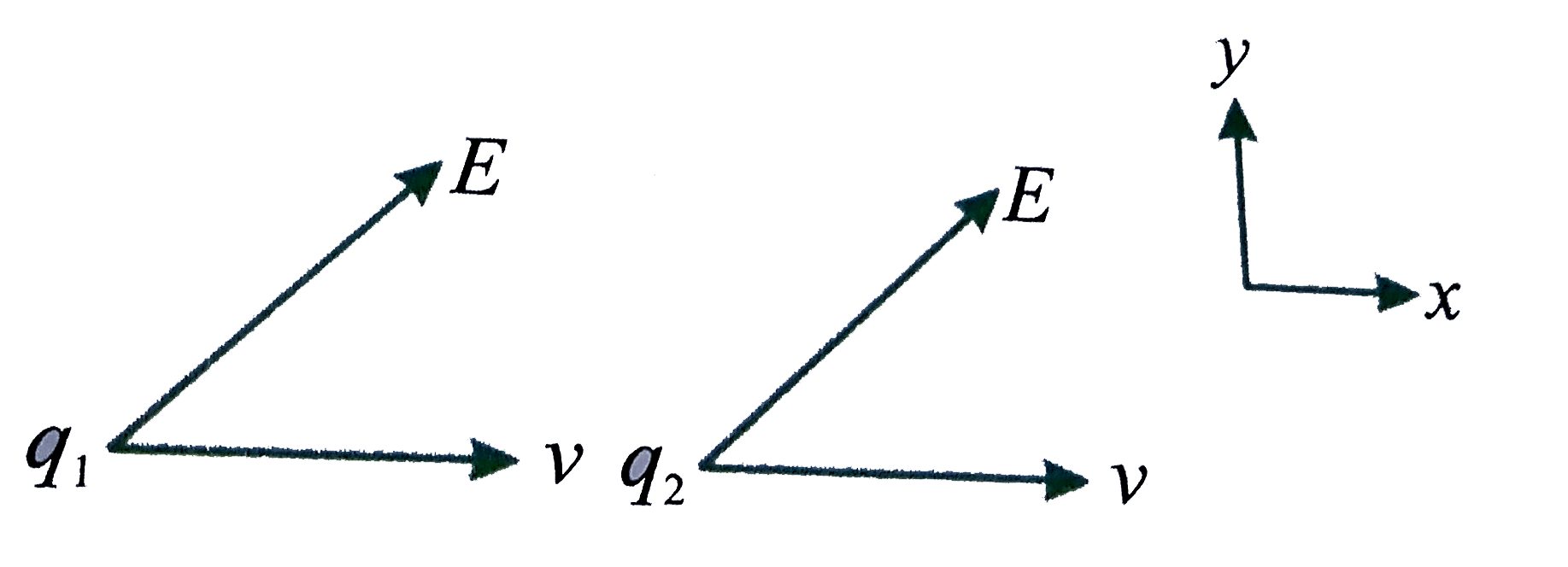Two balls of charges q1 and q2 initially have a velocity of the same magnitude and direction. After a uniform electric field has been applied for a certain time. The direction of the first ball changes by 60∘ and the velocity magnitude is reduced by half. The direction of velocity of the second ball changes by 90∘. In what ratio will the velocity of the second ball change? Determine, the magnitude of the charge to mass ratio of the second ball if it is equal to α1 for the first ball. Ignore the electrostatic interaction between the balls.
 ,
,
4α3
2α3
α3
α
The correct Answer is:A

Let →E=Exˆi+eyˆj
By impuse-momentum therorem
Impulse =change in momentum
⇒ Let the final velocity of balls be v1&v2=v2
q1[Exˆi+Eyˆj]Δt=m1(v2cos60ˆi+v2sin60ˆj)−m1vˆj
q2[Exˆi+Eyˆj]Δt
=m2(v2cos90ˆi+v2sin90ˆj)=m2vˆi
q1Ex(Δt)=−m13v4,q1EyΔt=m1√3v4
q2Ex(Δt)−m2v,q2Ey(Δt)=m2v2
⇒q1ExΔtq2ExΔt=m1m234⇒q2m2=4α3
Topper's Solved these Questions
- ELECTROSTATICS AND GAUSS LAWBook:NARAYNAChapter:ELECTROSTATICS AND GAUSS LAWExercise:Passage I
Explore 3 Videos
- ELECTROSTATICS AND GAUSS LAWBook:NARAYNAChapter:ELECTROSTATICS AND GAUSS LAWExercise:Passage II
Explore 3 Videos
- ELECTROSTATICS AND GAUSS LAWBook:NARAYNAChapter:ELECTROSTATICS AND GAUSS LAWExercise:NCERT based Question
Explore 14 Videos
- ELECTROSTATIC POTENTIAL AND CAPACITANCEBook:NARAYNAChapter:ELECTROSTATIC POTENTIAL AND CAPACITANCEExercise:ADDITIONAL PROBLEMS
Explore 14 Videos
- EXPERIMENTAL PHYSICSBook:NARAYNAChapter:EXPERIMENTAL PHYSICSExercise:Comprehension type
Explore 6 Videos
Similar Questions
Two balls of charges q1 and q2 initially have a velocity of the same nagnitude and direction. After a unform electric field has been applied for a certain time. The direction of the first ball changes by 60∘ and the velocity magnitude is reduced by half. The direction ofvelocity of the second ball changes by 90∘. In whata ratio will hte velociyt of the second ball change? Determine, the magnitude of the charge to mass ratio of the ball if it is equal to α1 for the firt ball. Ignore the electrostatic interactin between the balls.
 ,
,
View SolutionGive examles of variable velocity, when
(a) the magnitude is constant and the direction is changing
n (b) the manitude is cahnging and the driection remains the same
(c) both the magnitude and direction are changing
View Solution
Knowledge Check
The direction of velocity continuously changes in
Auniforme circular motionBnonuniforme circular motionCoscillatory motionDuniforme and non uniforme circular motionThe first ball of mass m moving with a velocity u collides head on with the second ball of mass m at rest. If the coefficient of restitution is e, the ratio of final velocity of the second ball to the initial velocity of the first ball is
A1−e1+eB1+e1−eC1+e2D1−e2The first ball of mass m moving with the velocity υ collides head on with the second ball of mass m at rest. If the coefficient of restitution is e, then the ratio of the velocities of the first and the second ball after the collision is
A1−e1+eB1+e1−eC1+e2D1−e2
Can the direction of motion of a body change if its velocity is changing at uniform rate ?
View SolutionA ball is thrown such that the time of flight is 5s and the horizontal range is 200m. Find the magnitude and direction of velocity of projection.
View SolutionBall 1 collides directly with another identical ball 2 at rest. Velocity of second ball becomes two times that of 1 after collison. Find the coefficient of restitution between the two balls?
View SolutionHow does the velocity of a ball thrown upwards change on its way?
View SolutionA ball of mass m moving with velocity u impinges on a ball of mass em moving with velocity eu in the opposite direction. If the impact be direct and e be the coefficient of restitution then the velocity of the second ball after impact is the same as that of the first ball before impact.
View Solution

